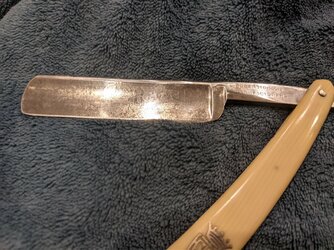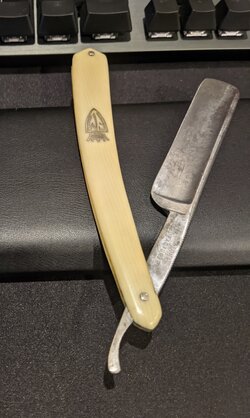I wanted to try restoring a straight razor but didn't have the patience for hand sanding. I got a hand-held rotary tool just like the Dremel, only it's not Dremel Brand. It's Parkside, sells in Lidl and is half the price of a Dremel. The price is the only reason why I got it instead of an original Dremel. At 160 watts it's powerfull enough. It Has 5 speed settings but you can run in sort of in between them, it's more of a linear switch.
I used the flexible extension shaft, it's very handy. Eye protection on at all times, no gloves though. I held the razor in the other hand. My bit was sort of DIY. I tried using a felt bit with metal polisher or stropping paste and it loaded in seconds and turned black. I didn't use the sandpaper discs you Can slide onto the rubber bit, but cut out a piece of my sandpaper and sticked it to that Rubber bit with double sided tape. It wasn't perfect, but it worked and gave me an option to go through a progression of grits. 400 to 800 to 1200 was more than enough, though I experimented with all of my 6 grits available.
It took only a few minutes to get to an acceptable stage on low grit to remove imperfections. This particular razor has very deep damage and I didn't want to remove so much steel as to preserve the etching. But it would be possible to go deeper and get to better steel. I will try that on the other razor I plan to restore.
For my next razor, I will prepare a system to hold the razor on the table (probably a big magnet) and I'll tape the bevel because it is already honed. It's very easy to slide the bit along the edge and make a little frown. I'll get a set of Radial bristle discs so I don't have to use my DIY flimsy "bits" as well as a 100 pack of felt bits to use with Diamond paste. That will allow me to go Higher in grit than the highest grit bristle disc and the felt wheel won't collect All the rust and so much material.
The areas that don't have deep damage turned out awesome. The rest is the rest, it's not perfect but it's way better then before. I would have to go veeery deep to remove it completely and get a clean Mirror finnish and it would remove the etching as well. That etching is the only thing making me want to keep that razor, that's why I won't go deeper.
Capturing the state of the blade is tricky, it's very different in photos. Under light it shines cleanly and Has a slight Mirror effect in areas with good steel, under shadow you Can still spot the damage in the most affected areas.
I'm satisfied with the result. Didn't injure myself, didn't chip or ruin the edge. Next time around I'll have a better setup and no reason not to go as far as I need to go in material removal to get a perfect finnish.
I used the flexible extension shaft, it's very handy. Eye protection on at all times, no gloves though. I held the razor in the other hand. My bit was sort of DIY. I tried using a felt bit with metal polisher or stropping paste and it loaded in seconds and turned black. I didn't use the sandpaper discs you Can slide onto the rubber bit, but cut out a piece of my sandpaper and sticked it to that Rubber bit with double sided tape. It wasn't perfect, but it worked and gave me an option to go through a progression of grits. 400 to 800 to 1200 was more than enough, though I experimented with all of my 6 grits available.
It took only a few minutes to get to an acceptable stage on low grit to remove imperfections. This particular razor has very deep damage and I didn't want to remove so much steel as to preserve the etching. But it would be possible to go deeper and get to better steel. I will try that on the other razor I plan to restore.
For my next razor, I will prepare a system to hold the razor on the table (probably a big magnet) and I'll tape the bevel because it is already honed. It's very easy to slide the bit along the edge and make a little frown. I'll get a set of Radial bristle discs so I don't have to use my DIY flimsy "bits" as well as a 100 pack of felt bits to use with Diamond paste. That will allow me to go Higher in grit than the highest grit bristle disc and the felt wheel won't collect All the rust and so much material.
The areas that don't have deep damage turned out awesome. The rest is the rest, it's not perfect but it's way better then before. I would have to go veeery deep to remove it completely and get a clean Mirror finnish and it would remove the etching as well. That etching is the only thing making me want to keep that razor, that's why I won't go deeper.
Capturing the state of the blade is tricky, it's very different in photos. Under light it shines cleanly and Has a slight Mirror effect in areas with good steel, under shadow you Can still spot the damage in the most affected areas.
I'm satisfied with the result. Didn't injure myself, didn't chip or ruin the edge. Next time around I'll have a better setup and no reason not to go as far as I need to go in material removal to get a perfect finnish.

